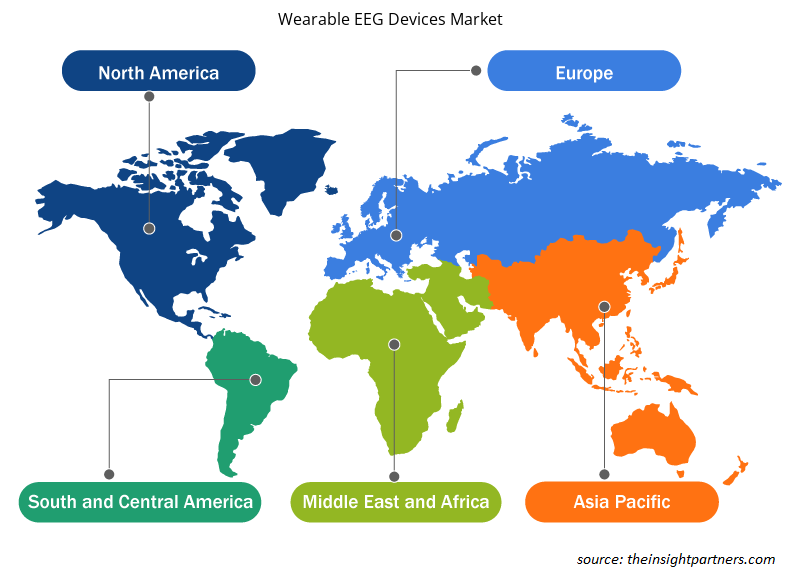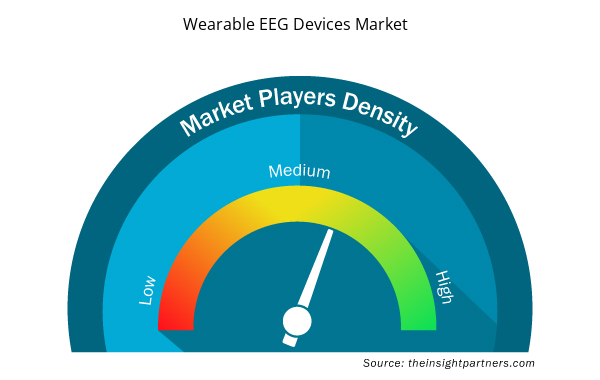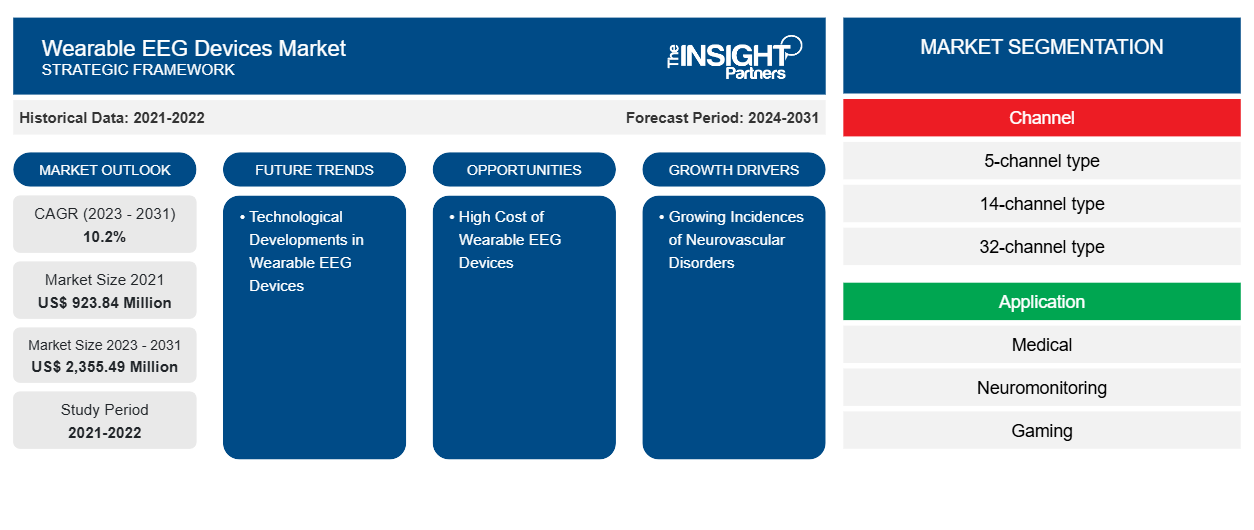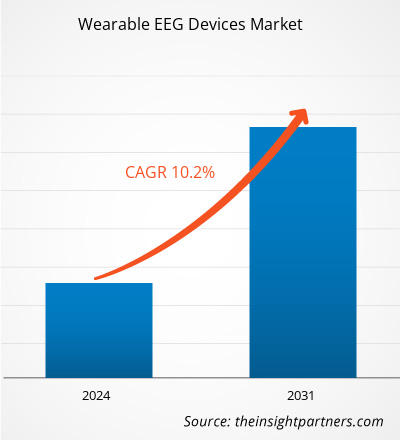The wearable EEG devices market size in 2021 stood at US$ 923.84 million and is projected to reach US$ 2,355.49 million by 2031 from US$ XX million in 2023. The market is expected to register a CAGR of 10.2% in 2023–2031. Growing research and developments, and product approvals and launches are likely to remain key wearable EEG devices market trends.
Wearable EEG Devices Market Analysis
There is growing global awareness of mental health issues, including stress, anxiety, and attention disorders. Neurofeedback, which involves real-time brain activity monitoring and training, has gained attention as a non-invasive approach to addressing these concerns. The efficiency and accuracy of neurofeedback systems have been improved by the advances in EEG technology and signal processing. Wearable EEG devices and other wearable technologies have made neurofeedback more accessible to a wider audience. Wearable EEG devices present a non-invasive and relatively inexpensive way to track brain activity in real time, helping in the early detection and better treatment of these diseases. Additionally, the market holds huge potential in emerging markets, with an increasing focus on improving healthcare infrastructure, increasing disposable income, changing lifestyles, and increasing healthcare spending.
Wearable EEG Devices Market Overview
Wearable EEG devices are characterized by their compact and user-friendly design, making them suitable for continuous monitoring outside traditional clinical environments. Due to the increasing cases of neurological diseases, the market is witnessing remarkable growth. Improved healthcare facilities, government initiatives, and increased mental health awareness drive this growth. The market is also characterized by increasing research and development activities, technological advancements, and strategic collaborations among key players.
Customize This Report To Suit Your Requirement
You will get customization on any report - free of charge - including parts of this report, or country-level analysis, Excel Data pack, as well as avail great offers and discounts for start-ups & universities
- Get Top Key Market Trends of this report.This FREE sample will include data analysis, ranging from market trends to estimates and forecasts.
Customize This Report To Suit Your Requirement
You will get customization on any report - free of charge - including parts of this report, or country-level analysis, Excel Data pack, as well as avail great offers and discounts for start-ups & universities
- Get Top Key Market Trends of this report.This FREE sample will include data analysis, ranging from market trends to estimates and forecasts.
Wearable EEG Devices Market Drivers and Opportunities
Growing Incidences of Neurovascular Disorders to Favor Market
The neurovascular diseases include ischemic stroke, hemorrhage stroke, brain tumors, etc. The lifestyle habits, genetic disorders, related chronic conditions may lead to the development of neurovascular diseases. The cases of neurological disorders have increased significantly during the past few years. Epilepsy, stroke, brain tumors, frontotemporal dementia, and Parkinson's disease are among the brain diseases that are believed to drive market expansion during the forecast period. According to the WHO, about 50 million people worldwide have epilepsy, and about 70% of people with epilepsy can live seizure-free with timely diagnosis and treatment. Further, according to the World Health Organization (WHO), 2010, stated that the total number of people with dementia across the globe is reported at 35.6 million and is anticipated to nearly double every 20 years, reaching to 65.7 million and ~115.4 million by 2030 and 2050, respectively.
Technology Advancements– An Opportunity for Wearable EEG Devices Market Growth
The continuous technological innovations that improve the efficiency and effectiveness of wearable EEG device products and services include advances in materials, manufacturing processes, and digital technologies. The advancement of edge computing, supported by 5G networks within IoT frameworks, has significantly expanded human sensory perception and interaction. An important biometric measurement within these IoT applications is electroencephalography (EEG), which is known for its sensitivity, cost-effectiveness, and uniqueness. Integrating EEG signals into biometric recognition systems represents a significant advance in identity authentication. EEG-based biometric recognition leverages the brain's distinctive and difficult-to-reproduce electrical activity, positioning it as a secure and innovative approach to identity verification. EEG records the brain's electrical activity and provides deep and dynamic insights into a person's cognitive processes. Integrating IoT and 5G into EEG systems represents a significant advance and opens new opportunities for improved data collection, processing, and use. Integrating IoT and 5G technologies into EEG systems significantly advances neurotechnology. This merger is intended to improve data collection, processing, and application, lead to deeper insights into the human brain, and promote innovative solutions in the healthcare and technology sectors. As these technologies continue to develop, their impact on EEG research and applications is expected to increase, thereby providing opportunity for market growth.
Wearable EEG Devices Market Report Segmentation Analysis
Key segments that contributed to the derivation of the wearable EEG devices market analysis are channel and application.
- Based on channel, the wearable EEG devices market is divided into 5-channel type, 14-channel type, 32-channel type, and others. In 2023, 32-channel type segment held the largest share of the market, and the same segment is estimated to register the highest CAGR during the forecast period.
- By application, the market is segmented into medical, neuromonitoring, gaming and others. In 2023, medical segment held the largest share of the market, and the same segment is anticipated to register the highest CAGR during 2023–2031.
Wearable EEG Devices Market Share Analysis by Geography
The geographic scope of the wearable EEG devices market report is mainly divided into five regions: North America, Asia Pacific, Europe, Middle East & Africa, and South America/South & Central America.
North America has dominated the wearable EEG devices market. The wearable EEG devices market growth in North America is attributed to increasing numbers of the neurological disorders such as brain tumors and stroke across the region. The US is expected to be the most prominent and fastest-growing market in North America. The US is among the highly advanced countries having various technologies available for a robust medical infrastructure, and it is globally known for its involvement in the research and development of the therapeutic techniques. In the Canadian population, neurological conditions are considered to be one of the leading cause of disabilities and are linked with a substantial public health burden. Mexico is counted among the top destinations for medical tourism, which provides cost-effective healthcare facilities. Numerous patients globally travel across the world for their treatments under the medical tourism plan. Thus, access to medical has expanded significantly in the past few years. Thus, owing to the developments undertaken by governments and non-government authorities, to improve the healthcare systems are likely to create growth opportunities for the growth of the market during the forecast period. However, Asia Pacific is expected to grow with the highest CAGR in the coming years.
Wearable EEG Devices Market Regional Insights
Wearable EEG Devices Market Regional Insights
The regional trends and factors influencing the Wearable EEG Devices Market throughout the forecast period have been thoroughly explained by the analysts at Insight Partners. This section also discusses Wearable EEG Devices Market segments and geography across North America, Europe, Asia Pacific, Middle East and Africa, and South and Central America.

- Get the Regional Specific Data for Wearable EEG Devices Market
Wearable EEG Devices Market Market Report Scope
| Report Attribute | Details |
|---|---|
| Market size in 2021 | US$ 923.84 Million |
| Market Size by 2031 | US$ 2,355.49 Million |
| Global CAGR (2023 - 2031) | 10.2% |
| Historical Data | 2021-2022 |
| Forecast period | 2024-2031 |
| Segments Covered |
By Channel
|
| Regions and Countries Covered | North America
|
| Market leaders and key company profiles |
Market Players Density: Understanding Its Impact on Business Dynamics
The Wearable EEG Devices Market market is growing rapidly, driven by increasing end-user demand due to factors such as evolving consumer preferences, technological advancements, and greater awareness of the product's benefits. As demand rises, businesses are expanding their offerings, innovating to meet consumer needs, and capitalizing on emerging trends, which further fuels market growth.
Market players density refers to the distribution of firms or companies operating within a particular market or industry. It indicates how many competitors (market players) are present in a given market space relative to its size or total market value.
Major Companies operating in the Wearable EEG Devices Market are:
- Natus Medical Incorporated,
- Koninklijke Philips N.V. (Electrical Geodesics, Inc.),
- Advanced Brain Monitoring, Inc.,
- ANT Neuro,
- Brain Products GmbH,
- Compumedics Neuroscan,
Disclaimer: The companies listed above are not ranked in any particular order.

- Get the Wearable EEG Devices Market top key players overview
Wearable EEG Devices Market News and Recent Developments
The wearable EEG devices market is evaluated by gathering qualitative and quantitative data post primary and secondary research, which includes important corporate publications, association data, and databases. The following is a list of developments in the market for wearable EEG devices:
- X-trodes, a bio-convergence company bringing wireless monitoring solutions to the home environment, today announced that the US Food and Drug Administration (FDA) has granted 510(k) clearance for X-trodes' Smart Skin solution (marketed as X-trodes System M), a new wireless wearable technology for advanced electrophysiological monitoring. (X-trodes, News, 2024)
- Elemind received US$ 12 million for wearable brain modulation device. The Elemind device is designed to improve the user’s memory and sleep quality without the need for any drug-based treatment. The wearable neurotechnology can read individual brainwaves and guide them in real time by responding with tailored stimulation. (ELEMIND TECHNOLOGIES, INC., News,2024)
- Presto Engineering, a European leading expert in application-specific integrated circuit (ASIC) design and semiconductor engineering and production services, and T&W Engineering, the leading in-ear electroencephalogram (EEG) wearable device developer and provider of artificial intelligence (AI)-driven EEG reading services, today announced their collaboration to develop an ASIC for measuring high quality, multi-channel dry-electrode EEG for next-generation wearable brain sensing. (Presto Engineering, News, 2023)
- Wearable Sensing launched a new Dry EEG + tDCS system developed in conjunction with Soterix Medical. This system integrates 6 customizable dry electrode EEG sensors, and 2 tDCS electrodes into a single headset. Our Machine Learning (aka AI) cognitive state classification algorithm, QStates, can be used to close the loop enabling automatic stimulation in response to set cognitive states. (Wearable Sensing, News, 2023)
Wearable EEG Devices Market Report Coverage and Deliverables
The “Wearable EEG DevicesMarket Size and Forecast (2021–2031)” report provides a detailed analysis of the market covering below areas:
- Market size and forecast at global, regional, and country levels for all the key market segments covered under the scope
- Market dynamics such as drivers, restraints, and key opportunities
- Key future trends
- Detailed PEST/Porter’s Five Forces and SWOT analysis
- Global and regional market analysis covering key market trends, major players, regulations, and recent market developments
- Industry landscape and competition analysis covering market concentration, heat map analysis, prominent players, and recent developments
- Detailed company profiles
- Historical Analysis (2 Years), Base Year, Forecast (7 Years) with CAGR
- PEST and SWOT Analysis
- Market Size Value / Volume - Global, Regional, Country
- Industry and Competitive Landscape
- Excel Dataset

Report Coverage
Revenue forecast, Company Analysis, Industry landscape, Growth factors, and Trends

Segment Covered
Channel ; Application , and Geography

Regional Scope
North America, Europe, Asia Pacific, Middle East & Africa, South & Central America

Country Scope
US, Canada, Mexico, UK, Germany, Spain, Italy, France, India, China, Japan, South Korea, Australia, UAE, Saudi Arabia, South Africa, Brazil, Argentina




 Get Free Sample For
Get Free Sample For